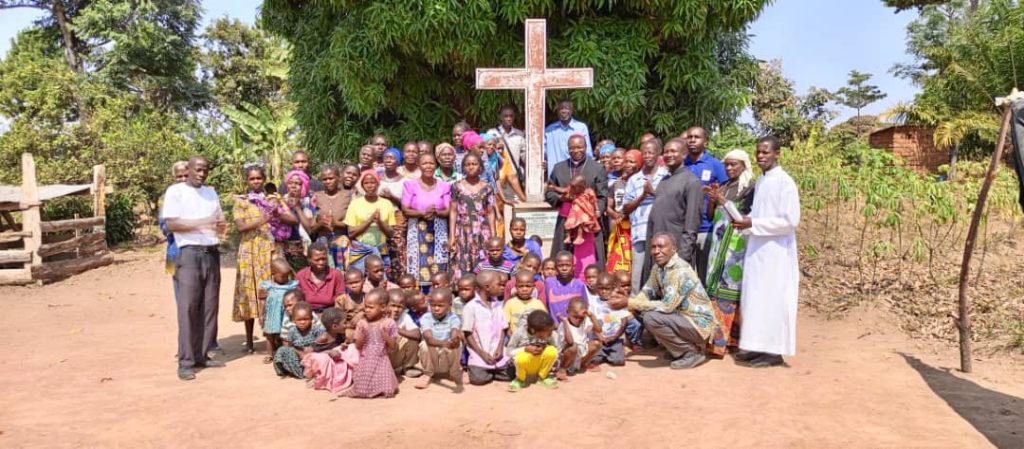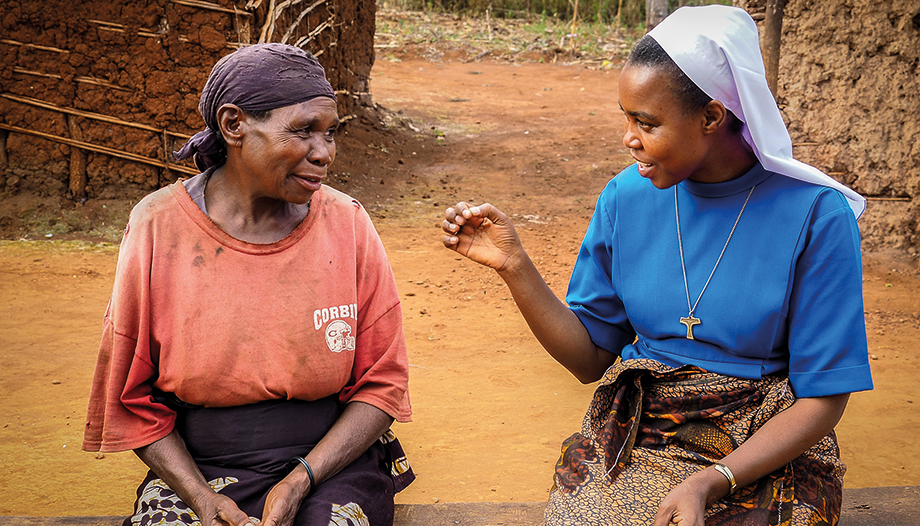 Monsignor Masondole: "In Africa there is no shame in saying 'I am a Christian'."
Monsignor Masondole: "In Africa there is no shame in saying 'I am a Christian'." Apollinaire Cibaka: "Humanae vitae speaks loudly to black Africa."
Apollinaire Cibaka: "Humanae vitae speaks loudly to black Africa."Evangelization in Uganda and Tanzania is quite recent, beginning only 150 years ago. It was Cardinal Lavigerie, the founder of the society Missionaries of Africa (known as the "White Fathers"), who organized an expedition of missionaries who arrived in these countries from Africa from the east (at that time there was no border between them, beyond the territorial delimitations of each tribe). The first group of missionaries left Marseilles on April 21, 1878, and about a month later, on May 30, 1878, a second group left, which succeeded in establishing a mission on the coast of Tanganyika and from there began a journey on foot to Lake Victoria.
This journey was not without its difficulties: shortly after setting out, the priest who led the expedition died of malaria.
As a result, the guides abandoned the group, which led to a change of plans. After securing new guides, the expedition members split into two groups to reach two different lakes, one of which is now Victoria.
130 Christians martyred
It was not until the following year, on February 17, 1879, that two of the missionaries, Father Simeo Lourdel and Brother Amans Delmas, managed to meet with the Kabaka Mutesa, a tribal chief who was impressed by their preaching and put 20 boats at their disposal so that the other missionaries could also cross the lake.
This territory had already been visited by Anglican preachers, which facilitated the mission at the beginning. But with the coming to power of a new kabaka, Mwanga II, came martyrdom, incited by the witchdoctors of the region. During the reign of Mwanga II, between November 1885 and mid 1886, 130 Christians were martyred, among them the famous "martyrs of Uganda", young locals who had converted to Christianity, both Anglicans and Catholics.
"They would have been more had it not been for the priests, who prevented them from voluntarily giving themselves up to martyrdom," it is stated in the book "Challenges of the first missionaries and the evangelization of the first catechists", by Father Andreas Msonge and Constantine Munyaga. "In June 1886 kabaka Mwanga expelled the missionaries from his territory. Some returned to Bukumbi, but Father Lourdel remained in hiding along with another priest and a brother to continue ministering to the incipient Christianity," the text continues.
The tables were turned when in 1888 the kabaka Mwanga was deposed and, since his life was in danger, he turned to the missionaries seeking refuge and asking forgiveness for his past conduct. When he returned to power in 1890, he gave the missionaries Mount Lubaga, where they were able to build the mission, as a gift in gratitude for the help they had given him in those difficult times.
However, due to a later conflict, this mission was burned down and rebuilt in 1892, the year in which the missionaries also arrived in the Ukerewe region, where they began to teach the people how to plant trees and make mud bricks, which brought the locals closer to them.
Numerous catechists killed
The preaching and the good relationship with the local people led to the construction of a village to which some catechists from Uganda moved.
However, the mtemi Lukange, chief of the region, began to fear that the missionaries had more power than he did, especially the catechist Cyrilo. He saw his influence on the villagers, who no longer came to his presence when the mtemi had the drums beaten. This situation led the mtemi Lukange to expel the missionaries from his territory.
Continuing their work, the evangelizers translated the catechism and the Bible into Kikerewe. However, they had to face martyrdom again when they began preaching against slavery and freeing slaves in the area. "The locals, angered by these practices, burned the kigango of Buguza and speared the catechists to death (their names are not preserved)." They also destroyed the missionaries' village of Namango.
The survivors, both catechumens and catechists, took refuge in the fortress of Mwiboma, where they suffered a two-day siege. Finally, the attackers managed to storm the fort and killed more than 28 people, being stopped by German soldiers who came to the rescue of the besieged.

The catechist Cyrilo, the same one who had previously been feared by the mtemi Lukange, although badly wounded, survived.
First priest from East Africa
The first East African priest was a Tanzanian from the Ukerewe territory, Father Celestine Kipanda Kasisi. Last year, at the celebration of the 75th anniversary of the parish of Itira, there were present at the ceremony some elderly people who had been baptized by him when they were children. Four of them received his name, Celestine, at the baptism. Since there is no word for "priest" in Swahili, "father" or "kasisi", the surname of Father Celestine, has been used since then as a translation of the word.
Christian majority
These were the first steps of the Church in Uganda and Tanzania. The structure that was followed, both in the beginning and in later years, was, first of all, to ask permission to evangelize from the chief of the region. If the chief agreed, he provided the missionaries with land on which to build the church and parish house, where they evangelized and taught catechism. Since the priest could not reach all the people, a group of well trained catechists was chosen, who were in charge of giving catechesis in the different communities and celebrating the liturgy of the word on Sundays. This system is the usual one in Tanzania also nowadays, due to the shortage of priests.
Today, the country enjoys a good religious coexistence and Christians can freely live their faith. In fact, the majority religion in Tanzania is Christianity, with 63.1 %, Catholicism being the most widespread confession, compared to 34.1 % for Islam, the second most practiced religion.
This is very positive data for such a young Church, only 150 years old. As in Europe, this situation has been achieved primarily thanks to the blood of numerous martyrs and missionaries who gave their lives for Jesus Christ.











